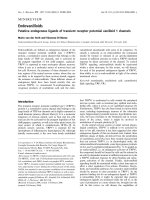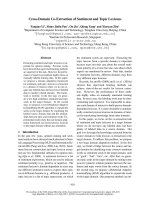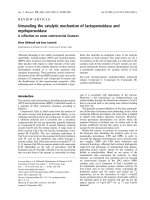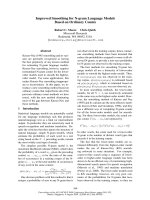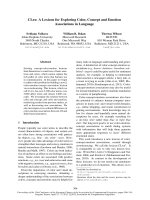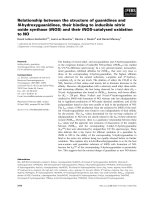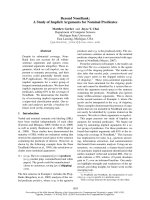Báo cáo khoa học: "Beyond Projectivity: Multilingual Evaluation of Constraints and Measures on Non-Projective Structures" doc
Bạn đang xem bản rút gọn của tài liệu. Xem và tải ngay bản đầy đủ của tài liệu tại đây (170.32 KB, 8 trang )
Proceedings of the 45th Annual Meeting of the Association of Computational Linguistics, pages 608–615,
Prague, Czech Republic, June 2007.
c
2007 Association for Computational Linguistics
Beyond Projectivity: Multilingual Evaluation
of Constraints and Measures on Non-Projective Structures
Ji
ˇ
r
´
ı Havelka
Institute of Formal and Applied Linguistics
Charles University in Prague
Czech Republic
Abstract
Dependency analysis of natural language
has gained importance for its applicability
to NLP tasks. Non-projective structures
are common in dependency analysis, there-
fore we need fine-grained means of describ-
ing them, especially for the purposes of
machine-learning oriented approaches like
parsing. We present an evaluation on
twelve languages which explores several
constraints and measures on non-projective
structures. We pursue an edge-based ap-
proach concentrating on properties of in-
dividual edges as opposed to properties of
whole trees. In our evaluation, we include
previously unreported measures taking into
account levels of nodes in dependency trees.
Our empirical results corroborate theoreti-
cal results and show that an edge-based ap-
proach using levels of nodes provides an
accurate and at the same time expressive
means for capturing non-projective struc-
tures in natural language.
1 Introduction
Dependency analysis of natural language has been
gaining an ever increasing interest thanks to its ap-
plicability in many tasks of NLP—a recent example
is the dependency parsing work of McDonald et al.
(2005), which introduces an approach based on the
search for maximum spanning trees, capable of han-
dling non-projective structures naturally.
The study of dependency structures occurring in
natural language can be approached from two sides:
by trying to delimit permissible dependency struc-
tures through formal constraints (for a recent review
paper, see Kuhlmann and Nivre (2006)), or by pro-
viding their linguistic description (see e.g. Vesel
´
a et
al. (2004) and Haji
ˇ
cov
´
a et al. (2004) for a linguistic
analysis of non-projective constructions in Czech.
1
)
We think that it is worth bearing in mind that
neither syntactic structures in dependency tree-
banks, nor structures arising in machine-learning ap-
proaches, such as MST dependency parsing, need a
priori fall into any formal subclass of dependency
trees. We should therefore aim at formal means ca-
pable of describing all non-projective structures that
are both expressive and fine-grained enough to be
useful in statistical approaches, and at the same time
suitable for an adequate linguistic description.
2
Holan et al. (1998) first defined an infinite hierar-
chy of classes of dependency trees, going from pro-
jective to unrestricted dependency trees, based on
the notion of gap degree for subtrees (cf. Section 3).
Holan et al. (2000) present linguistic considerations
concerning Czech and English with respect to this
hierarchy (cf. also Section 6).
In this paper, we consider all constraints and mea-
sures evaluated by Kuhlmann and Nivre (2006)—
with some minor variations, cf. Section 4.2. Ad-
1
These two papers contain an error concerning an alternative
condition of projectivity, which is rectified in Havelka (2005).
2
The importance of such means becomes more evident from
the asymptotically negligible proportion of projective trees to
all dependency trees; there are super-exponentially many unre-
stricted trees compared to exponentially many projective trees
on n nodes. Unrestricted dependency trees (i.e. labelled rooted
trees) and projective dependency trees are counted by sequences
A000169 and A006013 (offset 1), respectively, in the On-Line
Encyclopedia of Sequences (Sloane, 2007).
608
ditionally, we introduce several measures not con-
sidered in their work. We also extend the empirical
basis from Czech and Danish to twelve languages,
which were made available in the CoNLL-X shared
task on dependency parsing.
In our evaluation, we do not address the issue of
what possible effects the annotations and/or conver-
sions used when creating the data might have on
non-projective structures in the different languages.
The newly considered measures have the first or
both of the following desiderata: they are based
on properties of individual non-projective edges (cf.
Definition 3); and they take into account levels of
nodes in dependency trees explicitly. None of the
constraints and measures in Kuhlmann and Nivre
(2006) take into account levels of nodes explicitly.
Level types of non-projective edges, introduced
by Havelka (2005), have both desiderata. They pro-
vide an edge-based means of characterizing all non-
projective structures; they also have some further in-
teresting formal properties.
We propose a novel, more detailed measure, level
signatures of non-projective edges, combining lev-
els of nodes with the partitioning of gaps of non-
projective edges into components. We derive a for-
mal property of these signatures that links them to
the constraint of well-nestedness, which is an exten-
sion of the result for level types (see also Havelka
(2007b)).
The paper is organized as follows: Section 2 con-
tains formal preliminaries; in Section 3 we review
the constraint of projectivity and define related no-
tions necessary in Section 4, where we define and
discuss all evaluated constraints and measures; Sec-
tion 5 describes our data and experimental setup;
empirical results are presented in Section 6.
2 Formal preliminaries
Here we provide basic definitions and notation used
in subsequent sections.
Definition 1 A dependency tree is a triple
(V,→,), where V is a finite set of nodes, → a de-
pendency relation on V , and a total order on V .
3
3
We adopt the following convention: nodes are drawn top-
down according to their increasing level, with nodes on the
same level being the same distance from the root; nodes are
drawn from left to right according to the total order on nodes;
edges are drawn as solid lines, paths as dotted curves.
Relation → models linguistic dependency, and so
represents a directed, rooted tree on V . There are
many ways of characterizing rooted trees, we give
here a characterization via the properties of →: there
is a root r ∈V such that r →
∗
v for all v ∈V and there
is a unique edge p → v for all v ∈ V , v = r, and no
edge into r. Relation →
∗
is the reflexive transitive
closure of → and is usually called subordination.
For each node i we define its level as the length of
the path r →
∗
i; we denote it level
i
. The symmetriza-
tion ↔ = → ∪ →
−1
makes it possible to talk about
edges (pairs of nodes i, j such that i → j) without
explicitly specifying the parent (head; i here) and
the child (dependent; j here); so → represents di-
rected edges and ↔ undirected edges. To retain the
ability to talk about the direction of edges, we define
Parent
i↔ j
=
i if i → j
j if j → i
and Child
i↔ j
=
j if i → j
i if j → i
.
To make the exposition clearer by avoiding overuse
of the symbol →, we introduce notation for rooted
subtrees not only for nodes, but also for edges:
Subtree
i
= {v ∈ V | i →
∗
v}, Subtree
i↔ j
= {v ∈ V |
Parent
i↔ j
→
∗
v} (note that the subtree of an edge is
defined relative to its parent node). To be able to talk
concisely about the total order on nodes , we de-
fine open intervals whose endpoints need not be in
a prescribed order (i, j) = {v ∈ V | min
{i, j} ≺ v ≺
max
{i, j}}.
3 Condition of projectivity
Projectivity of a dependency tree can be character-
ized both through the properties of its subtrees and
through the properties of its edges.
4
Definition 2 A dependency tree T = (V,→,) is
projective if it satisfies the following equivalent con-
ditions:
i → j & v ∈ (i, j) =⇒ v ∈ Subtree
i
,
(Harper & Hays)
j ∈ Subtree
i
& v ∈ (i, j) =⇒ v ∈ Subtree
i
,
(Lecerf & Ihm)
j
1
, j
2
∈ Subtree
i
& v ∈ ( j
1
, j
2
) =⇒ v ∈ Subtree
i
.
(Fitialov)
Otherwise T is non-projective.
4
There are many other equivalent characterizations of pro-
jectivity, we give only three historically prominent ones.
609
It was Marcus (1965) who proved the equivalence
of the conditions in Definition 2, proposed in the
early 1960’s (we denote them by the names of those
to whom Marcus attributes their authorship).
We see that the antecedents of the projectiv-
ity conditions move from edge-focused to subtree-
focused (i.e. from talking about dependency to talk-
ing about subordination).
It is the condition of Fitialov that has been mostly
explored when studying so-called relaxations of pro-
jectivity. (The condition is usually worded as fol-
lows: A dependency tree is projective if the nodes
of all its subtrees constitute contiguous intervals in
the total order on nodes.)
However, we find the condition of Harper & Hays
to be the most appealing from the linguistic point
of view because it gives prominence to the primary
notion of dependency edges over the derived notion
of subordination. We therefore use an edge-based
approach whenever we find it suitable.
To that end, we need the notion of a non-
projective edge and its gap.
Definition 3 For any edge i ↔ j in a dependency
tree T we define its gap as follows
Gap
i↔ j
= {v ∈ V | v ∈ (i, j) & v /∈ Subtree
i↔ j
} .
An edge with an empty gap is projective, an edge
whose gap is non-empty is non-projective.
5
We see that non-projective are those edges i ↔ j
for which there is a node v such that together they
violate the condition of Harper & Hays; we group
all such nodes v into Gap
i↔ j
, the gap of the non-
projective edge i ↔ j.
The notion of gap is defined differently for sub-
trees of a dependency tree (Holan et al., 1998;
Bodirsky et al., 2005). There it is defined through
the nodes of the whole dependency tree not in the
considered subtree that intervene between its nodes
in the total order on nodes .
4 Relaxations of projectivity: evaluated
constraints and measures
In this section we present all constraints and mea-
sures on dependency trees that we evaluate empir-
5
In figures with sample configurations we adopt this con-
vention: for a non-projective edge, we draw all nodes in its gap
explicitly and assume that no node on any path crossing the span
of the edge lies in the interval delimited by its endpoints.
ically in Section 6. First we give definitions of
global constraints on dependency trees, then we
present measures of non-projectivity based on prop-
erties of individual non-projective edges (some of
the edge-based measures have corresponding tree-
based counterparts, however we do not discuss them
in detail).
4.1 Tree constraints
We consider the following three global constraints
on dependency trees: projectivity, planarity, and
well-nestedness. All three constraints can be applied
to more general structures, e.g. dependency forests
or even general directed graphs. Here we adhere to
their primary application to dependency trees.
Definition 4 A dependency tree T is non-planar if
there are two edges i
1
↔ j
1
, i
2
↔ j
2
in T such that
i
1
∈ (i
2
, j
2
) & i
2
∈ (i
1
, j
1
) .
Otherwise T is planar.
Planarity is a relaxation of projectivity that cor-
responds to the “no crossing edges” constraint. Al-
though it might get confused with projectivity, it is in
fact a strictly weaker constraint. Planarity is equiv-
alent to projectivity for dependency trees with their
root node at either the left or right fringe of the tree.
Planarity is a recent name for a constraint stud-
ied under different names already in the 1960’s—
we are aware of independent work in the USSR
(weakly non-projective trees; see the survey paper
by Dikovsky and Modina (2000) for references) and
in Czechoslovakia (smooth trees; Nebesk
´
y (1979)
presents a survey of his results).
Definition 5 A dependency tree T is ill-nested if
there are two non-projective edges i
1
↔ j
1
, i
2
↔ j
2
in T such that
i
1
∈ Gap
i
2
↔ j
2
& i
2
∈ Gap
i
1
↔ j
1
.
Otherwise T is well-nested.
Well-nestedness was proposed by Bodirsky et al.
(2005). The original formulation forbids interleav-
ing of disjoint subtrees in the total order on nodes;
we present an equivalent formulation in terms of
non-projective edges, derived in (Havelka, 2007b).
Figure 1 illustrates the subset hierarchy between
classes of dependency trees satisfying the particular
constraints:
projective planar well-nested unrestricted
610
projective planar
well-nested
unrestricted
Figure 1: Sample dependency trees (trees satisfy corre-
sponding constraints and violate all preceding ones)
4.2 Edge measures
The first two measures are based on two ways of
partitioning the gap of a non-projective edge—into
intervals and into components. The third measure,
level type, is based on levels of nodes. We also pro-
pose a novel measure combining levels of nodes and
the partitioning of gaps into components.
Definition 6 For any edge i ↔ j in a dependency
tree T we define its interval degree as follows
ideg
i↔ j
= number of intervals in Gap
i↔ j
.
By an interval we mean a contiguous interval in ,
i.e. a maximal set of nodes comprising all nodes be-
tween its endpoints in the total order on nodes .
This measure corresponds to the tree-based gap
degree measure in (Kuhlmann and Nivre, 2006),
which was first introduced in (Holan et al., 1998)—
there it is defined as the maximum over gap degrees
of all subtrees of a dependency tree (the gap degree
of a subtree is the number of contiguous intervals
in the gap of the subtree). The interval degree of an
edge is bounded from above by the gap degree of the
subtree rooted in its parent node.
Definition 7 For any edge i ↔ j in a dependency
tree T we define its component degree as follows
cdeg
i↔ j
= number of components in Gap
i↔ j
.
By a component we mean a connected component
in the relation ↔, in other words a weak component
in the relation → (we consider relations induced on
the set Gap
i↔ j
by relations on T ).
This measure was introduced by Nivre (2006);
Kuhlmann and Nivre (2006) call it edge degree.
Again, they define it as the maximum over all edges.
Each component of a gap can be represented by
a single node, its root in the dependency relation in-
duced on the nodes of the gap (i.e. a node of the com-
ponent closest to the root of the whole tree). Note
that a component need not constitute a full subtree
positive type
type 0
negative type
Figure 2: Sample configurations with non-projective
edges of different level types
of the dependency tree (there may be nodes in the
subtree of the component root that lie outside the
span of the particular non-projective edge).
Definition 8 The level type (or just type) of a non-
projective edge i ↔ j in a dependency tree T is de-
fined as follows
Type
i↔ j
= level
Child
i↔ j
− min
n∈Gap
i↔ j
level
n
.
The level type of an edge is the relative distance in
levels of its child node and a node in its gap closest
to the root; there may be more than one node wit-
nessing an edge’s type. For sample configurations
see Figure 2. Properties of level types are presented
in Havelka (2005; 2007b).
6
We propose a new measure combining level types
and component degrees. (We do not use interval de-
grees, i.e. the partitioning of gaps into intervals, be-
cause we cannot specify a unique representative of
an interval with respect to the tree structure.)
Definition 9 The level signature (or just signature)
of an edge i ↔ j in a dependency tree T is a mapping
Signature
i↔ j
: P (V) →
Z
N
0
defined as follows
Signature
i↔ j
= {level
Child
i↔ j
− level
r
|
r is component root in Gap
i↔ j
} .
(The right-hand s ide is considered as a multiset, i.e.
elements may repeat.) We call the elements of a sig-
nature component levels.
The signature of an edge is a multiset consisting
of the relative distances in levels of all component
roots in its gap from its child node.
Further, we disregard any possible orderings on
signatures and concentrate only on the relative dis-
tances in levels. We present signatures as non-
6
For example, presence of non-projective edges of nonnega-
tive level type in equivalent to non-projectivity of a dependency
tree; moreover, all such edges can be found in linear time.
611
decreasing sequences and write them in angle brack-
ets , component levels separated by commas (by
doing so, we avoid combinatorial explosion).
Notice that level signatures subsume level types:
the level type of a non-projective edge is the com-
ponent level of any of possibly several component
roots closest to the root of the whole tree. In other
words, the level type of an edge is equal to the largest
component level occurring in its level signature.
Level signatures share interesting formal proper-
ties with level types of non-projective edges. The
following result is a direct extension of the results
presented in Havelka (2005; 2007b).
Theorem 10 Let i ↔ j be a non-projective edge in a
dependency tree T . For any component c in Gap
i↔ j
represented by root r
c
with component level l
c
≤ 0
(< 0) there is a non-projective edge v → r
c
in T with
Type
v↔r
c
≥ 0 (> 0) such that either i ∈ Gap
v↔r
c
, or
j ∈ Gap
v↔r
c
.
PROOF. From the assumptions l
c
≤ 0 and r
c
∈
Gap
i↔ j
the parent v of node r
c
lies outside the
span of the edge i ↔ j, hence v /∈ Gap
i↔ j
. Thus
either i ∈ (v,r
c
), or j ∈ (v,r
c
). Since level
v
≥
level
Parent
i↔ j
, we have that Parent
i↔ j
/∈ Subtree
v
, and
so either i ∈ Gap
v↔r
c
, or j ∈ Gap
v↔r
c
. Finally from
l
c
= level
Child
i↔ j
− level
r
c
≤ 0 (< 0) we get level
r
c
−
level
Child
i↔ j
≥ 0 (> 0), hence Type
v↔r
c
≥ 0 (> 0).
This result links level signatures to well-
nestedness: it tells us that whenever an edge’s sig-
nature contains a nonpositive component level, the
whole dependency tree is ill-nested (because then
there are two edges satisfying Definition 5).
All discussed edge measures take integer values:
interval and component degrees take only nonneg-
ative values, level types and level signatures take
integer values (in all cases, their absolute values
are bounded by the size of the whole dependency
tree). Both interval and component degrees are de-
fined also for projective edges (for which they take
value 0), level type is undefined for projective edges,
however the level signature of projective edges is
defined—it is the empty multiset/sequence.
5 Data and experimental setup
We evaluate all constraints and measures described
in the previous section on 12 languages, whose tree-
banks were made available in the CoNLL-X shared
Figure 3: Sample non-projective tree considered
planar in empirical evaluation
task on dependency parsing (Buchholz and Marsi,
2006). In alphabetical order they are: Arabic, Bul-
garian, Czech, Danish, Dutch, German, Japanese,
Portuguese, Slovene, Spanish, Swedish, and Turk-
ish (H aji
ˇ
c et al., 2004; Simov et al., 2005; B
¨
ohmov
´
a
et al., 2003; Kromann, 2003; van der Beek et al.,
2002; Brants et al., 2002; Kawata and Bartels, 2000;
Afonso et al., 2002; D
ˇ
zeroski et al., 2006; Civit Tor-
ruella and Mart
´
ı Anton
´
ın, 2002; Nilsson et al., 2005;
Oflazer et al., 2003).
7
We do not include Chinese,
which is also available in this data format, because
all trees in this data set are projective.
We take the data “as is”, although we are aware
that structures occurring in different languages de-
pend on the annotations and/or conversions used
(some languages were not originally annotated with
dependency syntax, but only converted to a unified
dependency format from other representations).
The CoNLL data format is a simple tabular for-
mat for capturing dependency analyses of natural
language sentences. For each sentence, it uses a
technical root node to which dependency analyses of
parts of the sentence (possibly several) are attached.
Equivalently, the representation of a sentence can be
viewed as a forest consisting of dependency trees.
By conjoining partial dependency analyses under
one technical root node, we let all their edges inter-
act. Since the technical root comes before the sen-
tence itself, no new non-projective edges are intro-
duced. However, edges from technical roots may
introduce non-planarity. Therefore, in our empirical
evaluation we disregard all such edges when count-
ing trees conforming to the planarity constraint; we
also exclude them from the total numbers of edges.
Figure 3 exemplifies how this may affect counts of
non-planar trees;
8
cf. also the remark after D efini-
tion 4. Counts of well-nested trees are not affected.
7
All data sets are the train parts of the CoNLL-X shared task.
8
The sample tree is non-planar according to Definition 4,
however we do not consider it as such, because all pairs of
“crossing edges” involve an edge from the technical root (edges
from the technical root are depicted as dotted lines).
612
6 Empirical results
Our complete results for global constraints on de-
pendency trees are given in Table 1. They confirm
the findings of Kuhlmann and Nivre (2006): pla-
narity seems to be almost as restrictive as projectiv-
ity; well-nestedness, on the other hand, covers large
proportions of trees in all languages.
In contrast to global constraints, properties of in-
dividual non-projective edges allow us to pinpoint
the causes of non-projectivity. Therefore they pro-
vide a means for a much more fine-grained classifi-
cation of non-projective structures occurring in natu-
ral language. Table 2 presents highlights of our anal-
ysis of edge measures.
Both interval and component degrees take gen-
erally low values. On the other hand, Holan et al.
(1998; 2000) show that at least for Czech neither of
these two measures can in principle be bounded.
Taking levels of nodes into account seems to bring
both better accuracy and expressivity. Since level
signatures subsume level types as their last compo-
nents, we only provide counts of edges of positive,
nonpositive, and negative level types. For lack of
space, we do not present full distributions of level
types nor of level signatures.
Positive level types give an even better fit with
real linguistic data than the global constraint of well-
nestedness (an ill-nested tree need not contain a non-
projective edge of nonpositive level type; cf. The-
orem 10). For example, in German less than one
tenth of ill-nested trees contain an edge of nonpos-
itive level type. Minimum negative level types for
Czech, Slovene, Swedish, and Turkish are respec-
tively −1, −5, −2, and −4.
Level signatures combine level types and compo-
nent degrees, and so give an even more detailed pic-
ture of the gaps of non-projective edges. In some
languages the actually occurring signatures are quite
limited, in others there is a large variation.
Because we consider it linguistically relevant, we
also count how many non-projective edges contain
in their gaps a component rooted in an ancestor of
the edge (an ancestor of an edge is any node on the
path from the root of the whole tree to the parent
node of the edge). The proportions of such non-
projective edges vary widely among languages and
for some this property seems highly important.
Empirical evidence shows that edge measures of
non-projectivity taking into account levels of nodes
fit very well with linguistic data. This supports
our theoretical results and confirms that properties
of non-projective edges provide a more accurate
as well as expressive means for describing non-
projective structures in natural language than the
constraints and measures considered by Kuhlmann
and Nivre (2006).
7 Conclusion
In this paper, we evaluate several constraints and
measures on non-projective dependency structures.
We pursue an edge-based approach giving promi-
nence to properties of individual edges. At the same
time, we consider levels of nodes in dependency
trees. We find an edge-based approach also more
appealing linguistically than traditional approaches
based on properties of whole dependency trees or
their subtrees. Furthermore, edge-based properties
allow machine-learning techniques to model global
phenomena locally, resulting in less sparse models.
We propose a new edge measure of non-
projectivity, level signatures of non-projective
edges. We prove that, analogously to level types,
they relate to the constraint of well-nes tedness.
Our empirical results on twelve languages can
be summarized as follows: Among the global con-
straints, well-nestedness fits best with linguistic
data. Among edge measures, the previously unre-
ported measures taking into account levels of nodes
stand out. They provide both the bes t fit with lin-
guistic data of all constraints and measures we have
considered, as well as a substantially more detailed
capability of describing non-projective structures.
The interested reader can find a more in-depth and
broader-coverage discussion of properties of depen-
dency trees and their application to natural language
syntax in (Havelka, 2007a).
As future work, we plan to investigate more lan-
guages and carry out linguistic analyses of non-
projective structures in some of them. We will also
apply our results to statistical approaches to NLP
tasks, such as dependency parsing.
Acknowledgement The research reported in this
paper was supported by Project No. 1ET201120505
of the Ministry of Education of the Czech Republic.
613
Language Arabic Bulgarian Czech Danish Dutch German Japanese Portuguese Slovene Spanish Swedish Turkish
ill-nested 1 79 6 15 416 7 3 71 14
non-planar 150 677 13783 787 4115 10865 1 1713 283 56 1076 556
non-projective 163 690 16831 811 4865 10883 902 1718 340 57 1079 580
proportion of all (%) 11.16% 5.38% 23.15% 15.63% 36.44% 27.75% 5.29% 18.94% 22.16% 1.72% 9.77% 11.6%
all 1460 12823 72703 5190 13349 39216 17044 9071 1534 3306 11042 4997
Table 1: Counts of dependency trees violating global constraints of well-nestedness, planarity, and projectivity; the last line gives the total numbers
of dependency trees. (An empty cell means count zero.)
Language Arabic Bulgarian Czech Danish Dutch German Japanese Portuguese Slovene Spanish Swedish Turkish
ideg = 1 211 724 23376 940 10209 14605 1570 2398 548 58 1829 813
ideg = 2 1 189 5 349 1198 81 272 2 1 46 27
ideg = 3 3 8 37 12 24 9 1
cdeg = 1 200 723 23190 842 10264 13107 1484 2466 531 59 1546 623
cdeg = 2 10 1 292 78 238 2206 143 151 11 204 146
cdeg = 3 1 1 66 22 47 434 26 64 2 76 55
Type > 0 211 725 23495 942 10564 15803 1667 2699 547 59 1847 833
Type ≤ 0 75 3 2 41 3 3 50 8
Type < 0 4 2 15 2
Signature / count 1 / 92 2 / 674 2 / 18507 2 / 555 2 / 8061 2 / 8407 1 / 466 2 / 1670 2 / 384 2 / 46 2 / 823 2 / 341
2 / 56 3 / 32 1 / 2886 1 / 115 3 / 1461 1 / 3112 2 / 209 1 / 571 1 / 67 3 / 7 1 / 530 1 / 189
3 / 18 1 / 10 3 / 1515 3 / 100 1 / 512 1,1 / 1503 4 / 186 3 / 208 3 / 45 4 / 4 3 / 114 1, 1 / 91
4 / 10 4 / 5 4 / 154 1, 1 / 63 4 / 201 3 / 1397 3 / 183 1, 1 / 113 4 / 13 1 / 2 1,1 / 94 3 / 53
1,1 / 8 5 / 2 1,1 / 115 4 / 41 1, 1 / 118 2,2 / 476 5 / 126 1, 1, 1 / 44 5 / 12 0 / 31 2, 2 / 31
5 / 7 1,1,1 / 1 0 / 70 5 / 16 2,2 / 52 1, 1, 1 / 312 6 / 113 2, 2 / 29 1, 1 / 6 1,3 / 27 1, 1, 1 / 29
6 / 6 1,1 / 1 2,2 / 58 1, 1,1 / 16 1,1,1 / 25 4 / 136 7 / 78 2,2,2 / 13 6 / 4 1,1,1 / 25 4 / 19
7 / 4 1,1,1 / 48 2, 2 / 7 5 / 23 3,3 / 98 1, 1 / 63 4 / 12 1,1,1,1 / 4 4 / 21 2, 2,2 / 10
2,2 / 2 2,4 / 44 6 / 6 1,3 / 16 2,2,2 / 69 8 / 49 1,1,1,1 / 7 7 / 2 1, 2 / 19 3,3 / 6
9 / 1 1,3 / 32 2,2,2 / 6 3,3 / 15 1,1,1,1 / 59 9 / 35 1, 1, 1, 1,1 / 6 1,1,3 / 2 2,2 / 16 2, 2, 2,2 / 6
.
.
.
.
.
.
.
.
.
.
.
.
.
.
.
.
.
.
.
.
.
.
.
.
.
.
.
.
.
.
ancestor comp. root 39 711 20035 703 9781 10128 0 1832 392 57 950 345
only ancestor comp. r. 39 711 19913 685 9697 9526 0 1820 386 57 857 340
non-projective 211 725 23570 945 10566 15844 1667 2702 550 59 1897 841
proportion of all (%) 0.42% 0.41% 2.13% 1.06% 5.9% 2.4% 1.32% 1.37% 2.13% 0.07% 1.05% 1.61%
all 50097 177394 1105437 89171 179063 660394 126511 197607 25777 86028 180425 52273
Table 2: Counts for edge measures interval degree, component degree (for values from 1 to 3; larger values are not included), level type (for positive,
nonpositive, and negative values), level signature (up to 10 most frequent values), and numbers of edges with ancestor component roots in their gaps
and solely with ancestor component roots in their gaps; the second to last line gives the total numbers of non-projective edges, the last line gives the
total numbers of all edges—we exclude edges from technical roots. (The listings need not be exhaustive; an empty cell means count zero.)
614
References
A. Abeill
´
e, editor. 2003. Treebanks: Building and Using
Parsed Corpora, volume 20 of Text, Speech and Language
Technology. Kluwer Academic Publishers, Dordrecht.
S. Afonso, E. B ick, R. Haber, and D. Santos. 2002. “Floresta
sint
´
a(c)tica”: a treebank for Portuguese. In Proceedings of
the 3rd Intern. Conf. on Language Resources and Evaluation
(LREC), pages 1698–1703.
Manuel Bodirsky, Marco Kuhlmann, and Matthias M
¨
ohl. 2005.
Well-nested drawings as models of syntactic structure. In
Proceedings of Tenth Conference on Formal Grammar and
Ninth Meering on Mathematics of Language.
A. B
¨
ohmov
´
a, J. Haji
ˇ
c, E. Haji
ˇ
cov
´
a, and B. Hladk
´
a. 2003. The
PDT: a 3-level annotation scenario. In Abeill
´
e (2003), chap-
ter 7.
S. Brants, S. Dipper, S. Hansen, W. Lezius, and G. Smith. 2002.
The TIGER treebank. In Proceedings of the 1st Workshop on
Treebanks and Linguistic Theories (TLT).
S. Buchholz and E. Marsi. 2006. CoNLL-X shared task on
multilingual dependency parsing. In Proceedings of CoNLL-
X. SIGNLL.
M. Civit Torruella and M
a
A. Mart
´
ı Anton
´
ın. 2002. Design
principles for a Spanish treebank. In Proceedings of the 1st
Workshop on Treebanks and Linguistic Theories (TLT).
Alexander Dikovsky and Larissa Modina. 2000. Dependencies
on the other side of the Curtain. Traitement Automatique des
Langues (TAL), 41(1):67–96.
S. D
ˇ
zeroski, T. Erjavec, N. Ledinek, P. Pajas, Z.
ˇ
Zabokrtsky, and
A.
ˇ
Zele. 2006. Towards a Slovene dependency treebank. In
Proceedings of the 5th Intern. Conf. on Language Resources
and Evaluation (LREC).
J. Haji
ˇ
c, O. Smr
ˇ
z, P. Zem
´
anek, J.
ˇ
Snaidauf, and E. Be
ˇ
ska. 2004.
Prague Arabic dependency treebank: Development in data
and tools. In Proceedings of the NEMLAR Intern. Conf. on
Arabic Language Resources and Tools, pages 110–117.
Eva Haji
ˇ
cov
´
a, Ji
ˇ
r
´
ı Havelka, Petr Sgall, Kate
ˇ
rina Vesel
´
a, and
Daniel Zeman. 2004. Issues of Projectivity in the Prague
Dependency Treebank. Prague Bulletin of Mathematical
Linguistics, 81:5–22.
Ji
ˇ
r
´
ı Havelka. 2005. Projectivity in Totally Ordered Rooted
Trees: An Alternative Definition of Projectivity and Optimal
Algorithms for Detecting Non-Projective Edges and Projec-
tivizing Totally Ordered Rooted Trees. Prague Bulletin of
Mathematical Linguistics, 84:13–30.
Ji
ˇ
r
´
ı Havelka. 2007a. Mathematical Properties of Dependency
Trees and their Application to Natural Language Syntax.
Ph.D. thesis, Institute of Formal and Applied Linguistics,
Charles University in Prague, Czech Republic.
Ji
ˇ
r
´
ı Havelka. 2007b. Relationship between Non-Projective
Edges, Their Level Types, and Well-Nestedness. In Pro-
ceedings of HLT/NAACL; Companion Volume, Short Papers,
pages 61–64.
Tom
´
a
ˇ
s Holan, Vladislav Kubo
ˇ
n, Karel Oliva, and Martin Pl
´
atek.
1998. Two Useful Measures of Word Order Complexity.
In Alain Polgu
`
ere and Sylvain Kahane, editors, Proceedings
of Dependency-Based Grammars Workshop, COLING/ACL,
pages 21–28.
Tom
´
a
ˇ
s Holan, Vladislav Kubo
ˇ
n, Karel Oliva, and Martin Pl
´
atek.
2000. On Complexity of Word Order. Traitement Automa-
tique des Langues (TAL), 41(1):273–300.
Y. Kawata and J. Bartels. 2000. Stylebook for the Japanese
treebank in VERBMOBIL. Verbmobil-Report 240, Seminar
f
¨
ur Sprachwissenschaft, Universit
¨
at T
¨
ubingen.
M. T. Kromann. 2003. The Danish dependency treebank and
the underlying linguistic theory. In Proceedings of the 2nd
Workshop on Treebanks and Linguistic Theories (TLT).
Marco Kuhlmann and Joakim Nivre. 2006. Mildly Non-
Projective Dependency Structures. In Proceedings of COL-
ING/ACL, pages 507–514.
Solomon Marcus. 1965. Sur la notion de projectivit
´
e [On the
notion of projectivity]. Zeitschrift f
¨
ur Mathematische Logik
und Grundlagen der Mathematik, 11:181–192.
Ryan McDonald, Fernando Pereira, Kiril Ribarov, and Jan
Haji
ˇ
c. 2005. Non-Projective Dependency Parsing using
Spanning Tree Algorithms. In Proceedings of HLT/EMNLP,
pages 523–530.
Ladislav Nebesk
´
y. 1979. Graph theory and linguistics (chapter
12). In R. J. Wilson and L. W. Beineke, editors, Applications
of Graph Theory, pages 357–380. Academic Press.
J. Nilsson, J. H all, and J. Nivre. 2005. MAMBA meets TIGER:
Reconstructing a Swedish treebank from antiquity. I n Pro-
ceedings of the NODALIDA Special Session on Treebanks.
Joakim Nivre. 2006. Constraints on Non-Projective Depen-
dency Parsing. In Proceedings of EACL, pages 73–80.
K. Oflazer, B. Say, D. Zeynep Hakkani-T
¨
ur, and G. T
¨
ur. 2003.
Building a Turkish treebank. In Abeill
´
e (2003), chapter 15.
K. Simov, P. Osenova, A. Simov, and M. Kouylekov. 2005.
Design and implementation of the Bulgarian HPSG-based
treebank. In Journal of Research on Language and Com-
putation – Special Issue, pages 495–522. Kluwer Academic
Publishers.
Neil J. A. Sloane. 2007. On-Line Encyclopedia
of Integer Sequences. Published electronically at
www.research.att.com/˜njas/sequences/
.
L. van der Beek, G. B ouma, R. Malouf, and G. van Noord.
2002. The Alpino dependency treebank. In Computational
Linguistics in the Netherlands (CLIN).
Kate
ˇ
rina Vesel
´
a, Ji
ˇ
r
´
ı Havelka, and Eva Haji
ˇ
cov
´
a. 2004. Con-
dition of Projectivity in the Underlying Dependency Struc-
tures. In Proceedings of COLING, pages 289–295.
615
